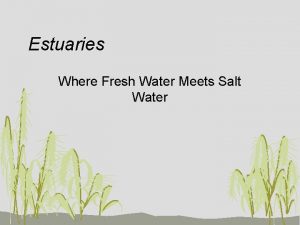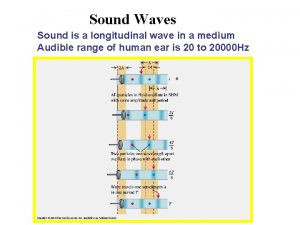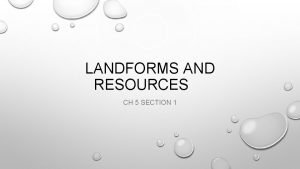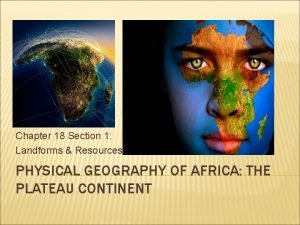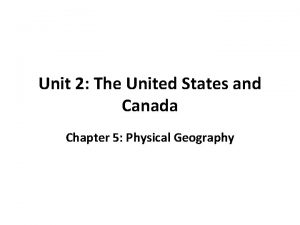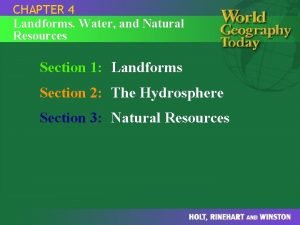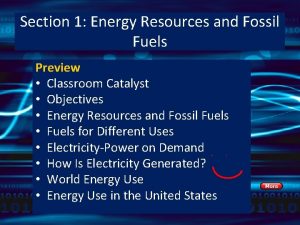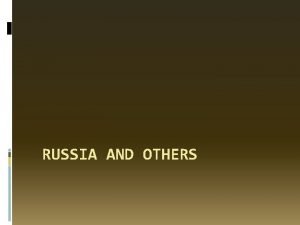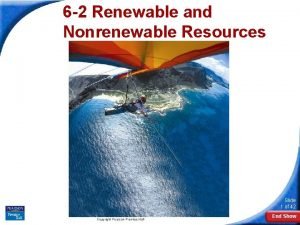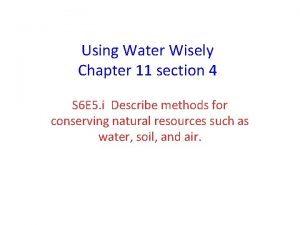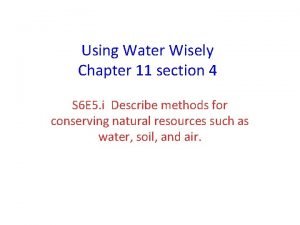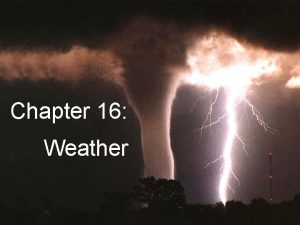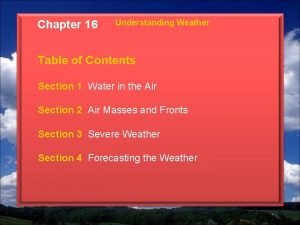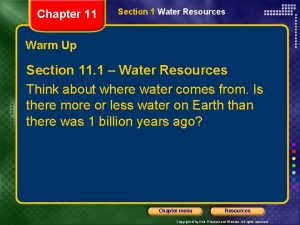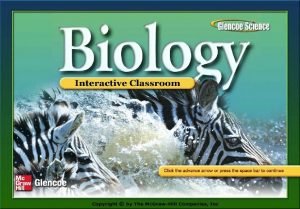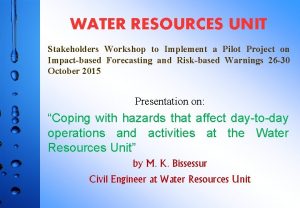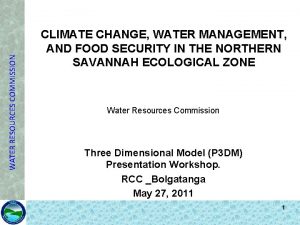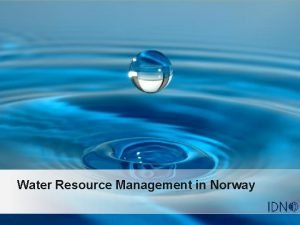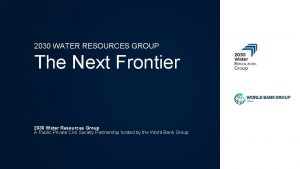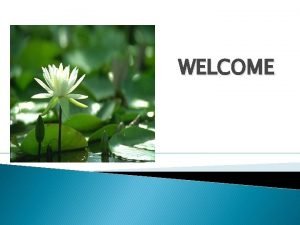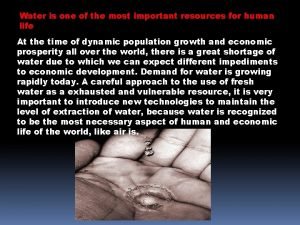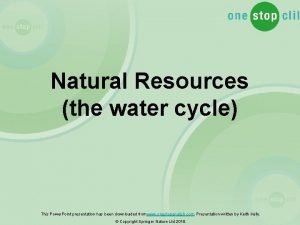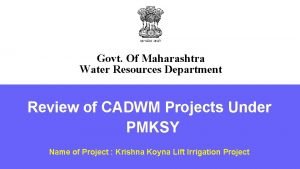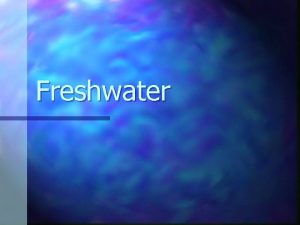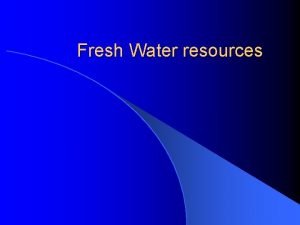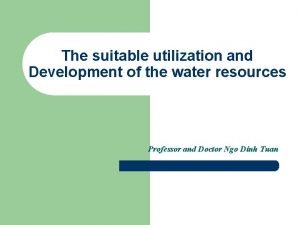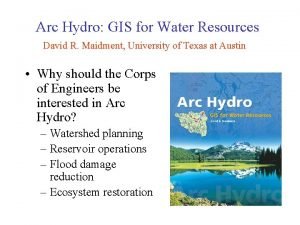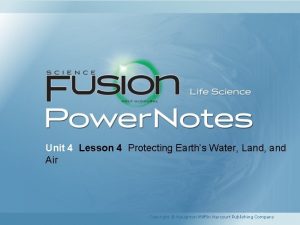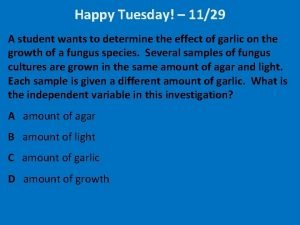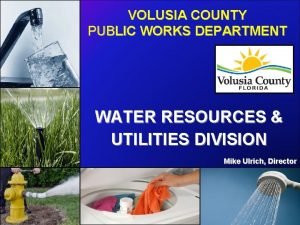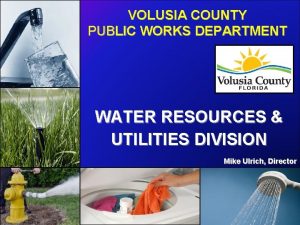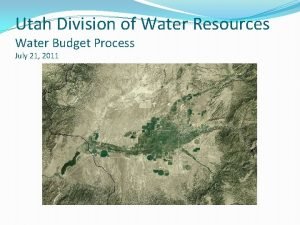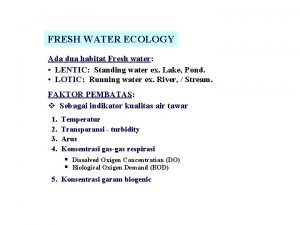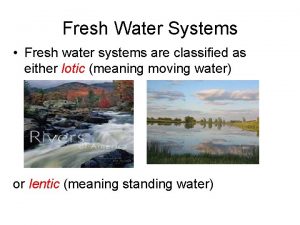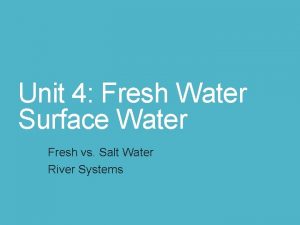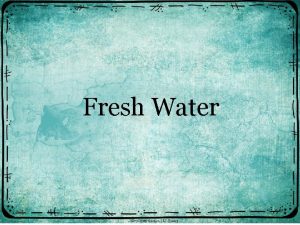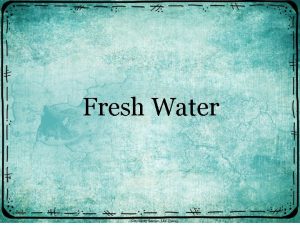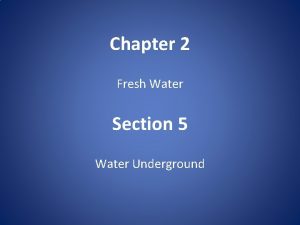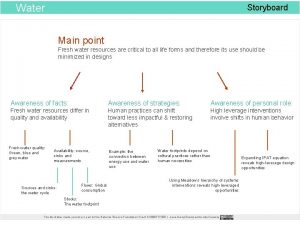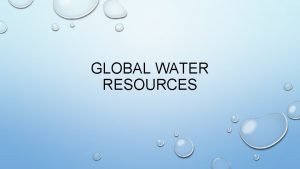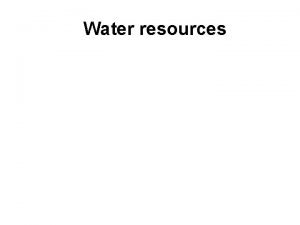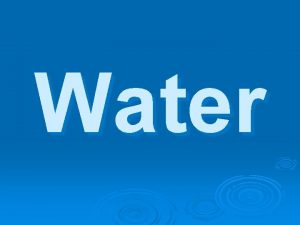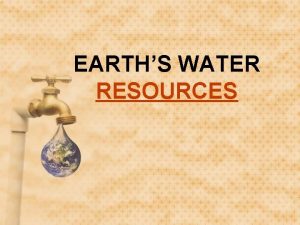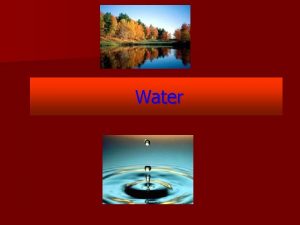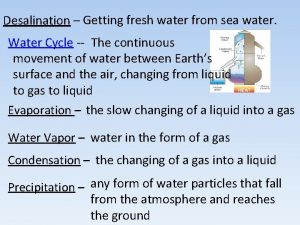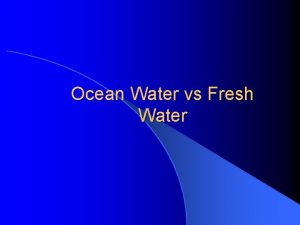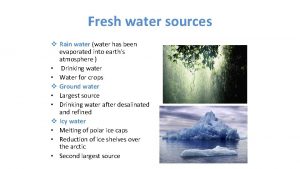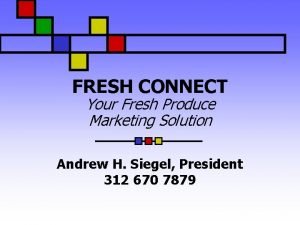Chapter 3 Fresh Water Resources Section 1 Water


















































- Slides: 50

Chapter 3 Fresh Water Resources Section 1: Water to Drink

u Ch. 3 Water to Drink, Section 1 Learning Objectives: Water to Drink u. Describe sources of drinking water and how it is treated and distributed. u. Explain what happens to waste water

u 1. Water quality The degree of purity of water, determined by measuring the substances in water, besides water molecules.

u 2. p. H How acidic or basic a substance is, measured on a scale of 1 (very acidic) to 14 (very basic).

u 3. Hardness The level of the minerals calcium and magnesium in water.

u 4. Concentration The amount of one substance in a certain volume of another substance.

Water Treatment Process u View before going over definitions: u http: //www. youtube. com/watch? v=9 z 14 l 51 ISwg

u 5. Filtration The process of passing water through a series of screens that allow the water through, but not larger solid particles.

u 6. Flocs Sticky globs created by adding a chemical such as alum during water treatment.

u 7. Coagulation The process by which particles in a liquid clump together; a step in the water treatment process.

Pharmaceuticals in Drinking Water u http: //www. youtube. com/watch? v=c 8 M 6 MRqir. Kk&feature=related u Fish Pharm u http: //www. youtube. com/watch? v=_ PWnnl. Vj 77 Y

u 8. Sewage Water containing human wastes.

Sewage Treatment Process u http: //www. youtube. com/watch? v=g xgp. K 1 EUZns&feature=related

u 9. Sludge Deposits of fine solids that settle out from wastewater during the treatment process.

u 10. Septic tank An underground tank containing bacteria that treat wastewater as it passes through.

u 11. Leach field The ground area around a septic tank through which wastewater filters after leaving the tank.

Notes u 1. Our drinking water either comes from surface a ________ or _______ water supply. underground

u 2. Four sources of drinking water a. lakes b. rivers c. reservoirs d. aquifer

u 3. acidity _____________, hardness _____________, and Disease-causing organisms ____________are three factors that affect water quality.

6 0 On the p. H scale ______ to ______ 7 would be acidic, ______is neutral, and 14 8 _____ to _____ is basic. u 4.

u 5. p. H stands for potential Hydrogen _____________. u u p. H level refers to the amount of acid and alkaline contained inside of both the water and the growing medium or soil. If the environment is too acidic, the plant will not attract enough hydrogen, while an environment that is too alkaline will attract too much hydrogen. An environment that continually fluctuates from one extreme on the p. H scale to the other is unhealthy for the plant.

hard _____ water contains high calcium levels of ________ and magnesium _______. u 6.

u 7. chlorine __________ is added to drinking water to Kill disease causing micro-organisms _____________.

Chapter 3 Fresh Water Section 2: Balancing Water Needs

u Drought A water shortage caused by scarce rainfall in a particular area.

u 13. Conservation The process of using a resource wisely so it will not be used up.

u 14. Desalination The process of obtaining fresh water from salt water by removing the salt.

u 1. A water shortage occurs when there too little is ________water, or too great demand a ________, or both.

u 2. Three major forms of water conservation by industries: – A. Reduce water – B. Recycle water – C. Reuse water

3. Two possible future sources of fresh Salt water (desalination) and water are__________. icebergs u *Environmental questions with the ice berg: How would a huge mass of ice offshore affect the local weather? What would happen to the living things as the ice cooled around it?

4. Five ways you can conserve water at home: u A. Take shorter showers u u B. Scrub vegetables in a basin of water, u C. Keep a pitcher of drinking water in the u D. Turn off the faucet instead of u E. Only run the washing machine when you have not under running water refrigerator instead of running the water till it gets cold letting it run a full load

Chapter 3 Fresh Water Section 3: Freshwater Pollution Water: The basics of use, pollution, and our health in 5 minutes. http: //www. youtube. com/watch? v=XMmpg 35 Bym 0

u 15. Water pollution The addition of any substance that has a negative effect on water or the living things that depend on the water.

u 16. Point source A specific source of pollution that can be identified, such as a pipe.

u 17. Nonpoint source A widely spread source of pollution that is difficult to link to a specific point of origin, such as road runoff.

u 18. Acid rain Rain that is more acidic than normal, caused by the release of molecules of sulfur dioxide and nitrogen oxide into the air.

u 19. Pesticide A chemical intended to kill insects and other organisms that damage crops.

u 1. Four major sources of water pollution are: Human wastes u A. u B. u C. u D. Industrial wastes Agricultural chemicals Runoff from roads

Cholera ____________ is bacteria in human caused by ________waste. u 2.

u 3. Three types of industrial pollutants: u A. Chemicals u B. Smoke and exhaust u C. Heat pollution

u 4. Acid _________rain is caused Sulfur dioxide by the _________and Nitrogen oxide ______released by smokestacks car, truck, bus and ______exhaust.

u 5. The rich supply of nutrients from fertilizers ___________encourages plants the growth of ________and algae in nearby bodies of water.

u What u See can you do? Dr. Eddie Widder is doing-Making Water Pollution Visible: u http: //www. youtube. com/watch? v=kzjss Ma. Qr 6 A

Chapter 3 Fresh Water Section 4: Water as an Energy Resource

u 20. Kinetic energy The form of energy that an object has when it is moving.

u 21. Potential energy Energy that is stored and waiting to be used.

u 22. Hydroelectric power Electricity produced by the kinetic energy of water moving over a waterfall or dam.

u 1. Four types of Energy in a Hydroelectric Power Plant u A. Kinetic energy-form of energy an object has when it is moving u B. Potential energy-energy stored and waiting to be used u C. u D. u u Hydroelectric power-electricity produced by the kinetic energy of water moving over a waterfall or a dam. Electrical energy Hydroelectric power: http: //www. youtube. com/watch? v=rn. PEtw. Qtm. GQ Pg. 107 in text

u 2. Three negative impacts a dam can have on an area u A. Flooding the land can destroy wildlife habitats as well as farms and towns u B. organisms can not survive the change of once fast moving waters becoming still The dam is a barrier across the river and it may prevent fish from traveling to the parts of a river u C. where they usually lay their eggs and young fish are hatched.

u Three positive impacts a dam can have on an area u A. Water power is the least expensive u B. u C. Water is the least polluting large scale energy source Dams can supply water for irrigation and help in flood control
 Apa arti fwa
Apa arti fwa Fresh water meets salt water
Fresh water meets salt water Chapter 11 section 1 water resources
Chapter 11 section 1 water resources Water and water and water water
Water and water and water water Whats a longitudinal wave
Whats a longitudinal wave Fresh water density
Fresh water density Chapter 24 the land where continents collided
Chapter 24 the land where continents collided Chapter 21 section 1 landforms and resources
Chapter 21 section 1 landforms and resources Landforms and resources section 1
Landforms and resources section 1 China population density
China population density Chapter 18 section 1 landforms and resources
Chapter 18 section 1 landforms and resources Chapter 5 section 1 landforms and resources
Chapter 5 section 1 landforms and resources Transformation processes
Transformation processes Fixed and variable resources
Fixed and variable resources Renewable resources vs nonrenewable resources
Renewable resources vs nonrenewable resources 14.2 uses of freshwater
14.2 uses of freshwater Chapter 4 landforms water and natural resources
Chapter 4 landforms water and natural resources Chapter 10 meiosis 1 and meiosis 2
Chapter 10 meiosis 1 and meiosis 2 Fossil fuels deposits
Fossil fuels deposits Landforms in moscow
Landforms in moscow Section 6-2 renewable and nonrenewable resources
Section 6-2 renewable and nonrenewable resources Chapter 11 section 4 using water wisely answer key
Chapter 11 section 4 using water wisely answer key Using water wisely
Using water wisely Chapter 16 section 1 water in the air answer key
Chapter 16 section 1 water in the air answer key Chapter 16 understanding weather answer key
Chapter 16 understanding weather answer key Chapter 11 section 3 water pollution answer key
Chapter 11 section 3 water pollution answer key Water pollution
Water pollution Chemistry in biology chapter 6
Chemistry in biology chapter 6 Water resources unit mauritius
Water resources unit mauritius Conclusion about water resources
Conclusion about water resources Norway water resources
Norway water resources Sabah water resources enactment 1998
Sabah water resources enactment 1998 Important of water management
Important of water management 2030 water resources group
2030 water resources group Hakaluki haor fill in the blanks
Hakaluki haor fill in the blanks Water is one of the most important resources
Water is one of the most important resources Natural resources water cycle
Natural resources water cycle Maharashtra water resources department
Maharashtra water resources department Water resources list
Water resources list Problems of water resources
Problems of water resources Conclusion of water resources
Conclusion of water resources Fish map
Fish map Air and water resources lesson 4
Air and water resources lesson 4 Determine
Determine Volusia county water and utilities
Volusia county water and utilities Volusia county utilities
Volusia county utilities Division of water resources utah
Division of water resources utah Oregon water resources department
Oregon water resources department A paved blacktop parking lot was built
A paved blacktop parking lot was built Trali symptoms
Trali symptoms Febrile nonhemolytic transfusion reaction
Febrile nonhemolytic transfusion reaction

